
FLORIDA KEYS
ELECTRIC COOPERATIVE





FLORIDA KEYS
ELECTRIC COOPERATIVE








JUNE 2025 Annual Meeting Recap
Islamorada earned third place in Florida Keys Electric Cooperative’s 2024 photo contest. The image was captured using a drone. Learn more about FKEC’s 2025 photo contest on Page 3.
New Chief Officers
New Business Hours




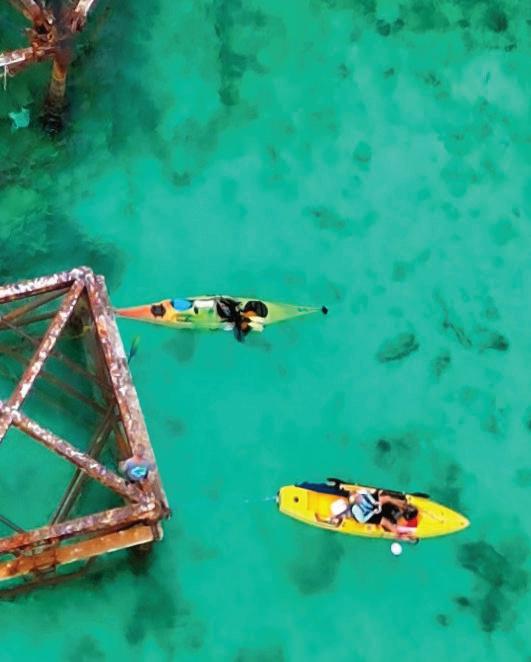

Where engineering excellence meets sleek design - a lightweight, safe, customizable, and stylish scooter for UNLIMITED FREEDOM
Numerous scooters with various features and capabilities are on the market, making it crucial to select the one that best suits your requirements.
At the age of 56, a back operation left me dependent on a cane, significantly impacting my daily life. Simple tasks like going to the store or meeting friends became challenging, and I even had to cancel a long-awaited anniversary trip to Italy.


Airline approved. Spacious legroom, comfortable seat



My husband purchased a scooter for me, but it was cumbersome and uncomfortable for everyday use, leaving me feeling more constrained than liberated. However, everything changed when I came across the ATTO SPORT. This remarkable scooter proved to be a game changer. Not only is it robust and reliable, but it also conveniently splits into two pieces, allowing me to effortlessly lift it into my car trunk on my own. I was even able to stow it in the overhead compartment on the plane, enabling us to finally take that trip to Italy! I am now independent once more, able to go wherever I please and do so with a striking sense of style. In fact, I now find that my husband struggles to keep up with me!




Independence and convenience: Easy to use and conveniently folds into a compact suitcase size for simple storage. It easily separates into two parts in seconds, with the heaviest piece weighing just 37 pounds, making it easier to lift into your car trunk.


Go anywhere: Conquer any terrain with puncture-proof, shock-absorbing tires and a 4-inch ground clearance. Equipped with electronic stability control for added safety on descents and turns, it is also flight-approved, ideal for air travel and cruise ships. With a driving range of up to 12.5 miles (25 miles with the XL battery), a top speed of 6.2 MPH, and a maximum weight capacity of 300 pounds, this durable scooter is designed for longevity.
Top-Notch Engineering: Guaranteeing both comfort and durability, this scooter offers ample legroom and a big comfortable seat. The ATTO is super portable and lightweight, and still rides like a heavy-duty scooter.
Unmatched Stylish Design: You deserve a mobility solution that doesn't just get you from A to B but makes you feel great while doing so. ATTO stands out from the crowd with its stunning design.
Splits into 2 lightweight parts for easy lifting



Folds in 3 seconds, rolls like a trolley suitcase






June 2025 • Volume 14, No. 8
CEO Michael Shepard
SENIOR VP OF CONTENT Leon Espinoza
EDITORIAL DIRECTOR Chasity Anderson, CCC
DEPUTY EDITORIAL DIRECTOR
Noble Sprayberry
SENIOR EDITOR Jennifer Paton, CCC
FLORIDA CURRENTS EDITORS
Valeri Saldanha Rosa; Sable Riley, CCC
ASSISTANT EDITORS Victoria Hampton, CCC;
David Herder, CCC
ASSOCIATE EDITOR
Nina Todea
PUBLICATIONS PRODUCTION
SENIOR MANAGER
Elizabeth Beatty
SENIOR PUBLICATIONS COORDINATOR
Alyssa McDougle
Members acknowledge that $4.49 a year, plus postage, is the cost to publish 12 issues a year of FLORIDA CURRENTS ISSN 23276304
(USPS 8300). Published by Pioneer Utility Resources Inc., 5625 NE Elam Young Parkway, Suite 100, Hillsboro, OR 97124—a not-for-profit Oregon cooperative corporation—the magazine serves the communication needs of consumerowned electric utilities in Florida. Preferred Periodicals postage paid at Hillsboro, OR 97123 and at additional mailing offices.
Postmaster: Send address changes to 5625 NE Elam Young Parkway, Suite 100, Hillsboro, OR 97124-6422.
HOW TO CONTACT FLORIDA CURRENTS
Subscription services:
Nonmember subscriptions $15 U.S. a year; $25 foreign a year. Prepayment required. Allow 4-8 weeks for first issue. Identify local edition desired. Have a problem receiving your magazine? Utility members should contact their utility office. Nonmembers call 503-357-2105 or email mailingdept@pioneer.coop.
Back issues:
Back issues and extra copies are $3 each, prepayment required. Supply is limited. Identify edition, month and year. Call first to check availability. Contact Pioneer Utility Resources: P.O. Box 1306, North Plains, OR 97133-1306; 503-357-2105; email: mailingdept@pioneer.coop.
DISPLAY ADVERTISING INQUIRIES
American MainStreet Publications 611 S. Congress Ave. Suite 504 Austin, TX 78704-1714; 800-626-1181 or 512-441-5200; amp.coop.
© 2025 Pioneer Utility Resources. All rights reserved. Reproduction in whole or in part without written permission is prohibited. Direct reprint requests to editor@floridacurrents.com or for more information, visit www.pioneer.coop.




Once again, it’s time for Florida Keys Electric Co-op’s cover photo contest.
We welcome all FKEC member photographers—novice and pros—to enter for a chance to win a $25 electric bill credit and have their photo featured on the cover of Florida Currents magazine.
• Each member may submit up to five photos.
• All submissions must include the photographer’s name and the location where the photo was taken.
• For contact purposes only, include your email address and phone number.
• All submitted photos must be taken within FKEC’s service territory (Monroe-Dade county line to the Seven Mile Bridge).
• The contest is open to FKEC members only.
• Submissions must be high-resolution, vertical digital images in .jpg or .pdf format, sized approximately 8 inches wide by 10 inches tall.
• Prints will not be accepted.
• Judging will be conducted by Florida Currents editors.
The deadline to submit photos is Friday, July 25. Email high-resolution images to news@FKEC.com with the subject line “Photo Contest.”
By submitting photos, you grant FKEC the right to use them in the Florida Currents magazine and on the Florida Keys Electric Cooperative website and social media.

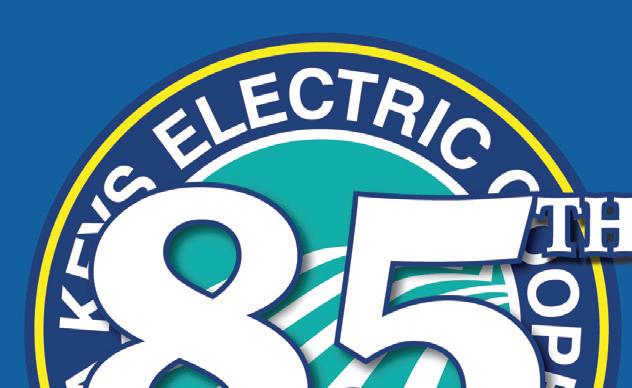
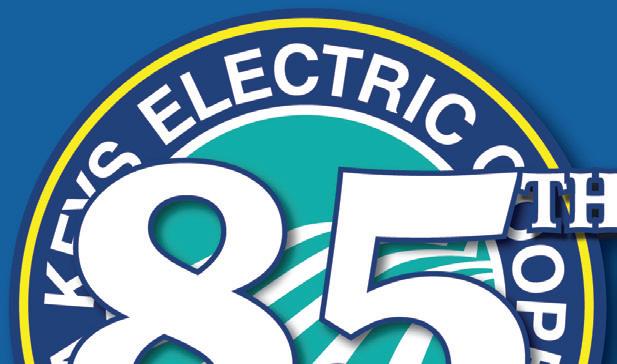




FLORIDA KEYS ELECTRIC COOPERATIVE ASSOCIATION, INC.
Member Owned Since 1940
BOARD OF DIRECTORS
Karl Wagner
District 4, Marathon, President
Michael H. Puto
District 4, Marathon, Vice President
Cale Smith
District 3, Islamorada, Treasurer
Gretchen Holland
District 1, Key Largo, Secretary
James J. Boilini
District 1, Key Largo
David C. Ritz
District 1, Key Largo
Craig Belcher
District 2, Tavernier
Joseph H. Roth III
District 2, Tavernier
George D. Hertel
District 3, Islamorada
CONTACT US:
305-852-2431 | 800-858-8845
Pay by Phone 855-940-4007 www.FKEC.com
Mailing Address:
P.O. Box 377, Tavernier, FL 33070
MEMBERS SHOULD KNOW:
Simplify Your Residential Rental Property Management with the Landlord Automatic Transfer of Service Program. Learn more at www.FKEC.com/landlord-autotransfer/.
On Saturday, April 26, Florida Keys Electric Cooperative proudly hosted its Annual Meeting at Coral Shores High School—this year celebrating 85 years of service to our Upper and Middle Keys community.
Each year, this event serves as more than a meeting—it’s a tradition that underscores the cooperative spirit and our strong member relationships. We were happy to welcome over 250 members to connect and reflect with us this year.
Members were greeted with registration gifts, raffle tickets, and complimentary coffee and breakfast wraps—perfect for catching up with neighbors, FKEC directors, and staff before the meeting officially began.
At 10:00 a.m., Board President Karl Wagner called the meeting to order while Secretary Gretchen Holland confirmed the quorum and verified compliance with FKEC’s bylaws, affirming the meeting’s official standing.
Karl then introduced FKEC’s dedicated Board of Directors—the nine individuals who guide the co-op with vision and accountability. He also offered special recognition to the members of our Charitable Trust Board. These volunteers oversee Operation Roundup®, ensuring member-donated funds are put to powerful use helping local causes.
Following that, Treasurer Cale Smith presented the financial report, providing


SCOTT NEWBERRY Chief Executive Officer
an overview of the co-op’s 2024 Operating Statement and Balance Sheet. His presentation underscored FKEC’s continued financial strength and operational stability.
Finally, I had the honor of addressing our valued members. First, I reported our achievements in Safety, Reliability and Cost. In 2024, our Safety Incident Rate Goal was less than 4 and we well surpassed that achieving a 0.84 rate. We also set a new record in reliability with only 22.7 minutes out. And, we remain one of the lowest priced utilities in Florida.
Then I looked back at FKEC’s 85 years in existence particularly the years of 1964, 1990 and 2025. Those years may seem random, but it is the year I was born, the year I started at FKEC and today.
One of my favorite historical comparisons to share at the meeting was our cost, then and now. Our average residential cost


per 1,000 kWh is currently $118, whereas in 1964 it was $27. This difference might make you nostalgic for the “good old days,” but keep in mind that $27 in 1964 is equivalent to $273 today. So, FKEC’s cost increase to you, our members, has been less than half the rate of inflation since 1964. I am proud of our team for operating efficiently and keeping our rates low
My presentation also highlighted how the job of providing electricity has changed over the last 85 years. From crews climbing poles and hoisting transformers with pulleys to linemen being lowered onto transmission poles by helicopter, it’s been a remarkable transformation.
Ifyoumissedthemeeting,youcan watchitonlineatwww.FKEC.com/newsand-info/video-library/ ■
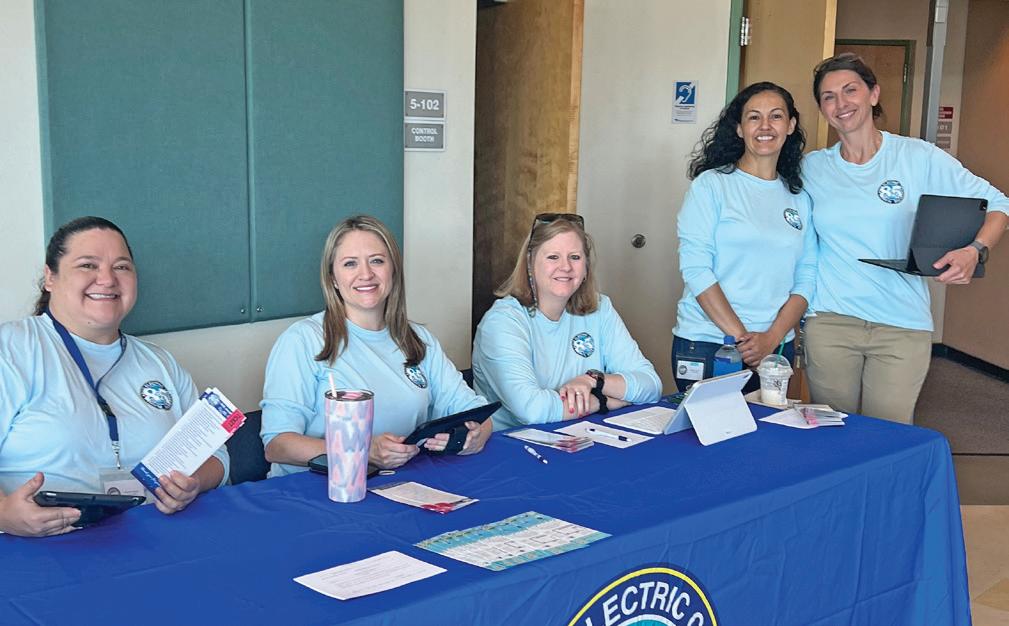



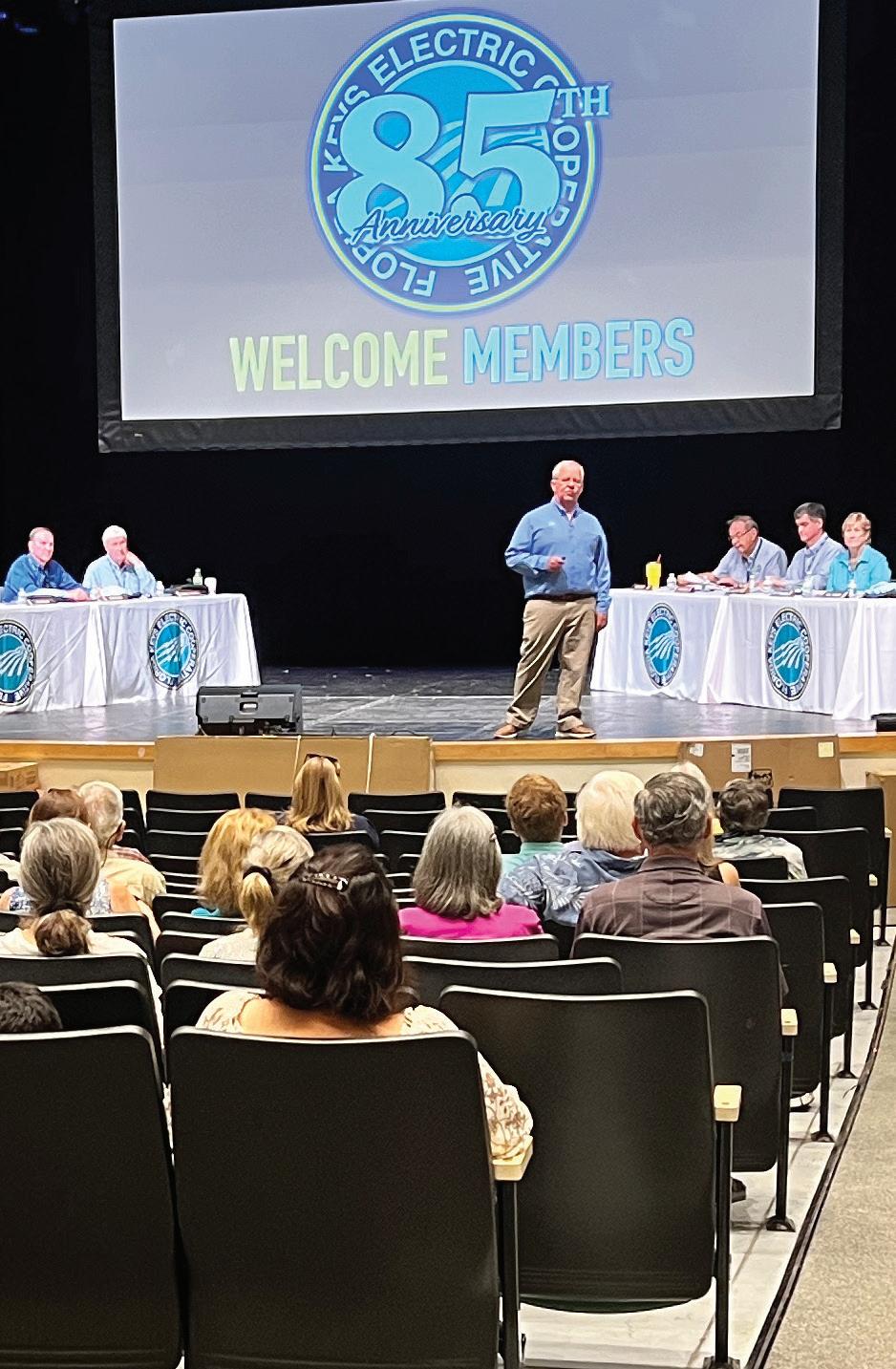
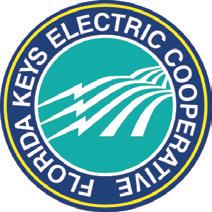




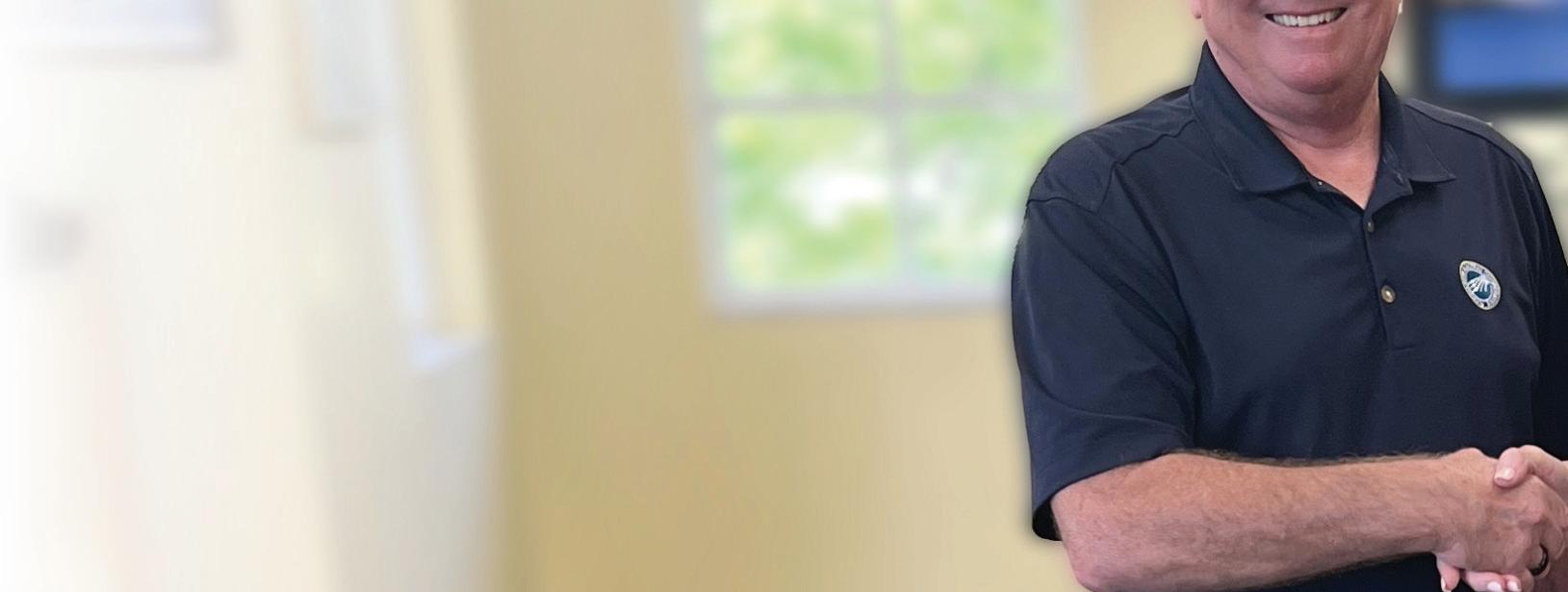



Chief Executive Officer Scott Newberry recently named Maria Jones Chief Administrative Officer—a newly created role designed to enhance consumer relations and operational efficiency to better serve FKEC members.

Florida Keys Electric Cooperative is proud to announce the promotion of Maria Jones to the newly created position of Chief Administrative Officer. Maria has also been named Assistant General Manager and will work closely with CEO and General Manager Scott Newberry, Chief Financial Officer Cris Beaty, and Chief Information Officer Tamie Fox.
As CAO, Maria oversees Member Services, Customer Relations, and Consumer Accounting—ensuring streamlined, high-quality service to FKEC members. “With more than 25 years of experience at the co-op, Maria’s intricate knowledge of FKEC operations, commitment to member satisfaction, and strong leadership make her exceptionally prepared and well-suited for this role,” explained CEO Scott Newberry.

Maria previously served as FKEC’s Director of Member Services and Government Relations, where she was steadfast in her dedication to serving co-op members and leading her team with vision and care. Her ability to build relationships—both within the utility and across local and state government—has advanced FKEC’s mission to be a strong community partner.
Over the years, Maria has continually expanded her expertise, completing NRECA’s Executive Leadership Program in October 2024 and the Robert I. Kabat Management Internship Program (MIP) in June 2023. These nationally recognized programs underscore her readiness to lead with strategy, insight, and a strong cooperative spirit.
Beyond her professional achievements, Maria is a passionate community advocate. She currently serves on the Board of Directors for the Upper Keys Rotary Club and recently concluded 12


years of dedicated service on the United Way of Collier and the Keys (UWCK) Regional Board. She continues her involvement with UWCK as a member of the local advisory board which she has been a part of for decades. Maria is also a graduate of Leadership Monroe County Class XX and a former board member of both Leadership Monroe County and the Islamorada Chamber of Commerce.
Maria’s contributions have not gone unnoticed. She was honored as one of The Citizen and Free Press’s Citizen’s Choice Outstanding Individuals and recognized in Keys Weekly’s Keys Women magazine for her commitment to uplifting the Florida Keys community.
As Chief Administrative Officer and Assistant General Manager, she will continue to provide strategic leadership and operational oversight—reinforcing the cooperative’s role as a reliable and integral part of the Upper and Middle Keys.

Please join us in congratulating Maria and thanking her for taking on her next role at the cooperative.
FKEC is also excited to announce Tamie Fox as the Chief Information Officer—a position created to reinforce the cooperative’s commitment to staying at the forefront of technology.
Tamie brings more than 25 years of experience in Information Technology, with a strong background in computer support, server and network administration, programming, and IT management. Her broad expertise helps to keep every aspect of FKEC’s technology operation relevant and secure.
Since stepping into leadership of FKEC’s IT department in 2017, Tamie has significantly expanded the cooperative’s investment in both Information and Operational Technology. Under her direction, FKEC has strengthened its cybersecurity measures, improved system reliability, and increased

technological efficiency across all departments.
“Tamie is the ideal fit for this role,” said Chief Financial Officer Cris Beaty. “She combines deep technical knowledge with a strong understanding of the cooperative’s operations and goals. Her leadership has been instrumental in modernizing our systems while keeping security and reliability top of mind.”
In addition to researching, evaluating, and implementing leading-edge security and IT solutions, Tamie has emphasized the importance of staff education and awareness. She introduced interactive training initiatives to make cybersecurity an engaging and accessible topic for her co-workers.
Tamie holds a Bachelor of Science in Information Technology from Oregon Technical Institute, graduating with highest honors, Summa Cum Laude. She is a member of Phi Theta Kappa Honor Society and actively contributes to the industry as part of the NRECA Project Guardian Cybersecurity Group.
Congratulations, Tamie. ■









FKEC congratulates Veronica Ornelas on her promotion to Director of Member Services.
Veronica will now lead the Member Service department and oversee Consumer Accounts.
Veronica has been with FKEC for 14 years, most recently serving as Member Service and Customer Relations Manager. Throughout her career, she has consistently demonstrated a strong commitment to FKEC’s members and the cooperative’s mission to provide exceptional customer service. Her extensive experience in both Member Services and Consumer Accounts makes her well-prepared for her new role.
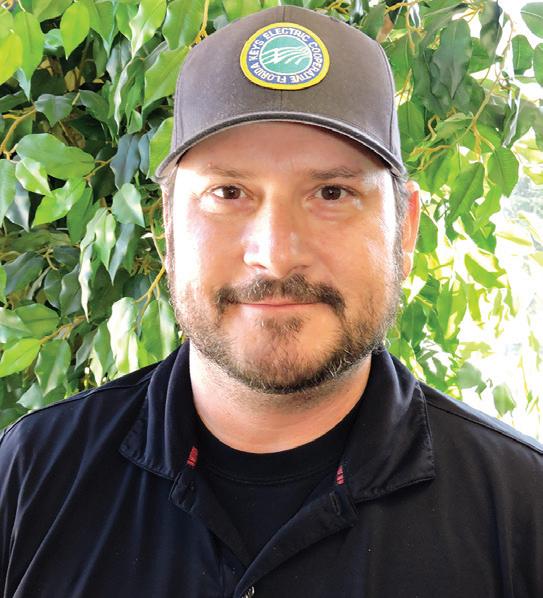
FKEC also congratulates Dave DiMaggio on his promotion to Information Technology Manager.
Since joining the cooperative in 2013 as part of the IT Department, Dave has brought strong leadership and technical expertise to support FKEC’s technology needs. His promotion reflects both his valuable contributions and his readiness to take on a larger leadership role. As IT Manager, Dave will continue to lead the department in delivering secure, efficient, and innovative technology solutions that support FKEC team members across all departments.
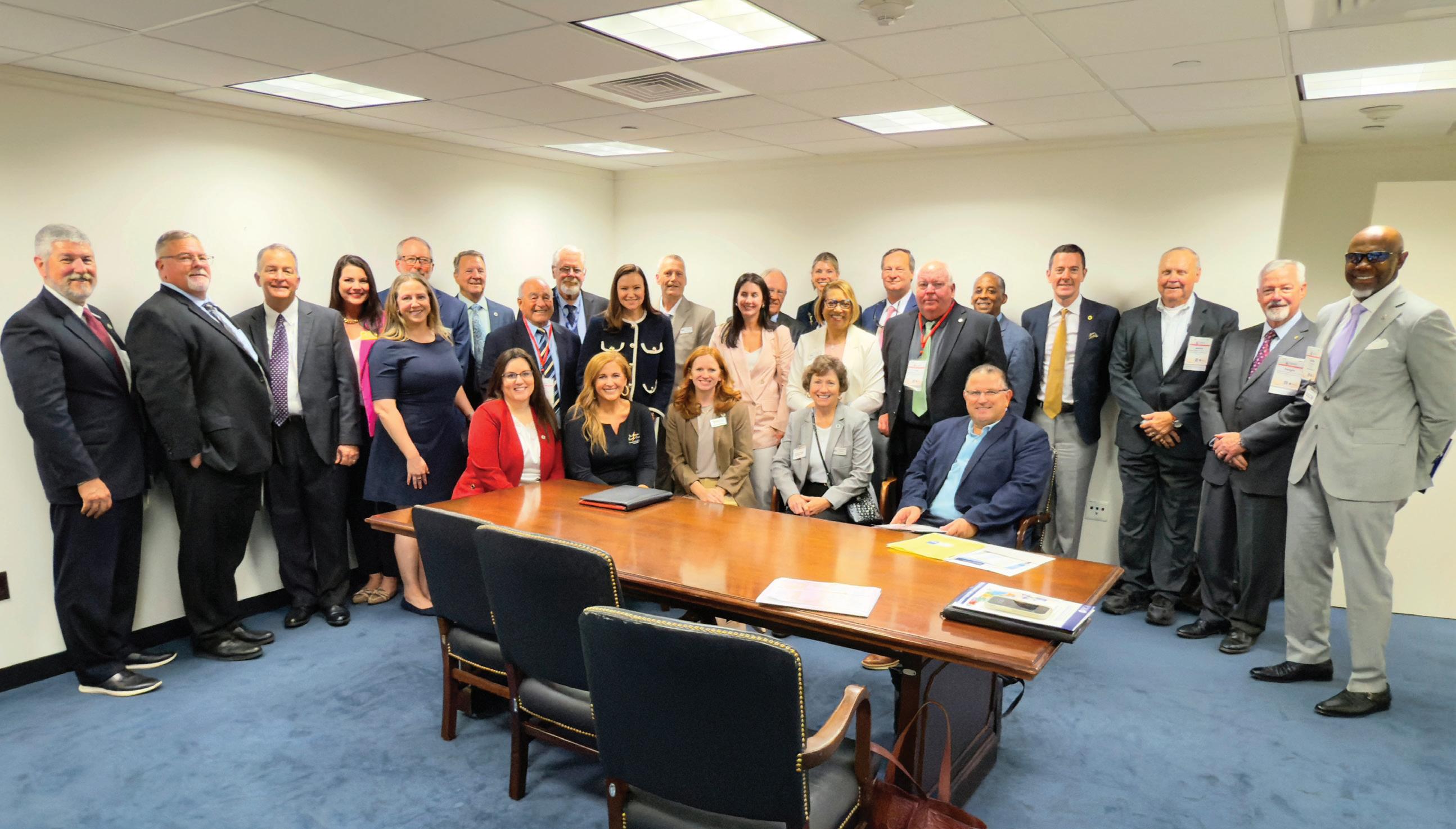





Each April, leaders from electric cooperatives across the United States gather in Washington, D.C. to advocate for common co-op issues and improve service to consumermembers.
The National Rural Electric Cooperative Association (NRECA) organizes the event and leads informational sessions preparing co-op leaders to discuss federal issues the electrical cooperatives are currently battling.
This year, Florida Keys Electric Cooperative Board of Directors Craig Belcher, David Ritz, and Dr. James Boilini joined representatives from other Florida co-ops to visit with legislators and attend informational sessions.
Our directors met with Congressmen and Senators to discuss issues such as the importance of the Federal Emergency Management Agency (FEMA) and how
electric co-ops rely on reimbursements after an emergency to keep rates low. What Are the Issues?
• Co-ops support the FEMA Loan Interest Payment Relief Act to reimburse interest expenses incurred while waiting years for FEMA to reimburse disaster-related power restoration expenses. Florida electric cooperatives have paid more than $12 million in interest in recent years while waiting for FEMA reimbursements.
• Permitting Reform is needed, as the overly bureaucratic federal permitting process imposes unreasonable timelines and drives up costs for essential infrastructure projects needed for Florida’s continued growth.
• Rural Utilities Service

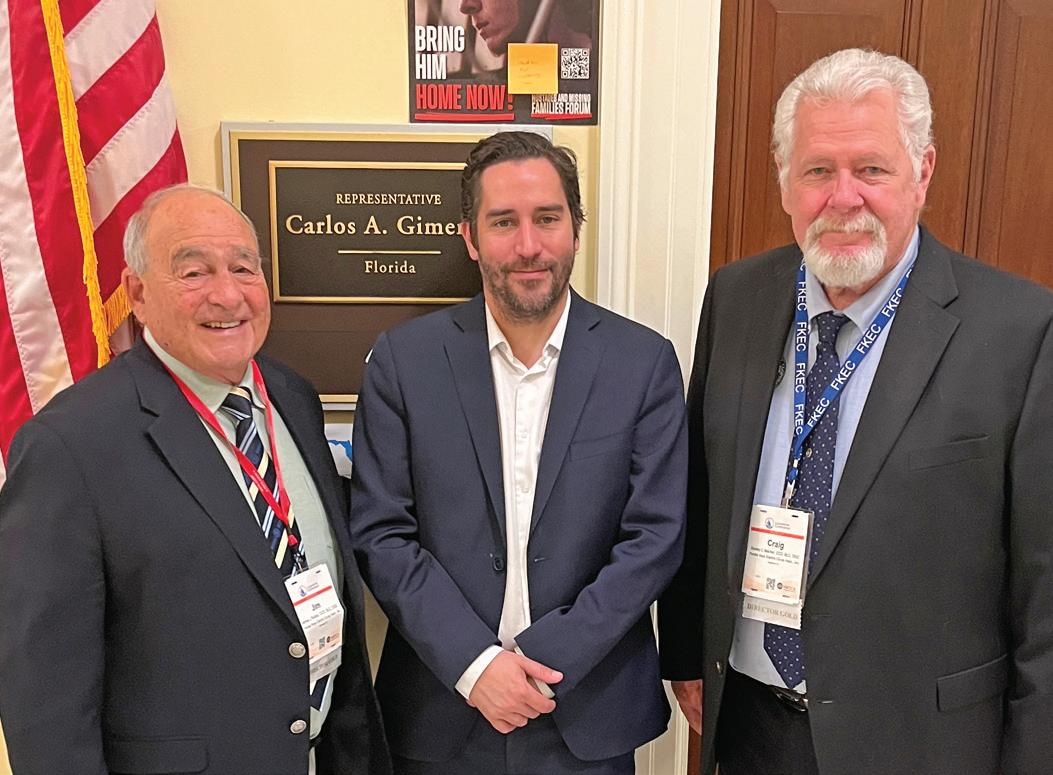
FKEC Directors Dr. James Boilini (left) and Craig Belcher (right) with a staff member from Congressman Carlos Gimenez’s office in Washington, D.C. Each year, FKEC leadership visits Capitol Hill to advocate for our communities and emphasize the importance of safe, reliable, and affordable electricity. PHOTO COURTESY OF FLORIDA ELECTRIC COOPERATIVES ASSOCIATION
(RUS) Loans & Elective Pay energy taxes are two programs that assist electric co-ops investing in the electric infrastructure needed to meet our community’s future energy needs.
•Supply Chain issues continue to make it difficult and expensive for electric co-ops to obtain materials and equipment needed to keep the lights on.■





By Les O’Dell
Livestock production in Florida is as diverse as the farmers, ranchers, shepherds and homesteaders who raise agricultural animals. From large commercial cattle and swine operations to families with a few rabbit hutches and a flock of chickens, the state boasts a wide range of livestock producers, all with their own reasons for raising the breeds they do.
For some Florida agriculturalists, one reason is conservation. These breeders choose less common varieties of animals for their farms and homesteads.
Known as heritage breeds, these traditional livestock breeds are a throwback to a time before industrial agriculture became a mainstream practice. According to The Livestock Conservancy, a North Carolina-based not-for-profit organization

working to promote and protect these animals, the breeds were carefully selected and bred over time to develop traits that made them well adapted to the local environment. They thrive under farming practices and cultural conditions that are very different from some found in modern agriculture.
Because of unique characteristics— such as slower rates of weight gain— these breeds fell out of favor with commercial producers, pushing some to the brink of extinction. Today, The Livestock Conservancy lists more than 180 agricultural breeds across 11 species—ranging from rabbits, ducks and geese to cattle, horses and pigs—on its Conservation Priority List an annual report ranking the danger of disappearance of each breed, classified from the most serious, or Critical, down to Threatened, Watch and Recovering. Based on these rankings, conservationists work to preserve these breeds.
Take Scott and Sherry Crossman, for example. On their Stafford’s Prairie Ranch near Williston, the couple raise Florida Cracker cattle, a breed listed as “Threatened” on the CPL. Descending
from Spanish cattle brought to North America in the 1500s, it is one of the oldest breeds in the United States. How the Crossmans came to select the breed—which is heat-tolerant, resistant to parasites and diseases, and thrives on lowquality grasslands—is a story itself. When purchasing the ranch, they discovered Sherry’s great-great-grandfather had owned the property in the mid-1800s and raised hundreds of Florida Cracker cattle there. The Crossmans chose to honor the legacy and have come to love the breed.
“As we studied the history of the Cracker cattle, we recognized the uniqueness of their genetic makeup and then, of course, the need to preserve those genes,” Scott says.
Other Florida breeders understand the importance of genetic preservation. Rick Blaney and Heidi Reinhardt have what they believe to be the world’s largest herd of critically endangered Galiceno horses at their Galicenos of Suwannee Horse Ranch near Live Oak. Although small in size compared to many equine breeds— Galicenos mature at 12-13.2 hands, or 48-54 inches—they are an intelligent and gentle breed, fully capable of carrying an

adult human with a smooth gait that is easy on the rider.
“These horses are unique,” Rick says. “They are descendants of the first horses brought to the new world by Columbus and Cortez. Plus, I have a long history of working with endangered species, and when I found out how endangered this breed was, it was a natural transition to focus on saving the genetics of this breed. That really caught my attention.”
Heidi says she loves the breed for other reasons.
“My adoration for this breed comes from their size, stature, stamina, personalities, varieties of solid colors and the ease with which I can train them,” she says.
The pair says their role goes beyond simply raising the horses.
“Our mission is saving the breed and educating people about them. This is such an important breed in history that people need to know about them,” Rick adds.
Paul Bradshaw, owner of Greenfire Farms in Midway, sells rare and vanishing varieties of chickens from around the world. His efforts have been responsible for doubling the number of chicken breeds in the United States, including several Conservation Priority List varieties, including Crevecouer (Watch), Icelandic (Threatened) and Spitzhauben (Watch).
He reports that Greenfire Farms has more than 1,000 birds representing more than four dozen breeds.
“Our basic thesis is that chickens are a vital source of animal protein globally, both with eggs and meat, but commercially, it is a very genetically limited and vulnerable population,” Paul says, adding that keeping living birds is key. “Unlike a seed bank or with mammals where you can freeze genetics, you can’t do that with chicken. You must have live chickens, so essentially, we have the biggest chicken gene bank in the world. If we don’t do that, we paint ourselves into a corner.”
Securing biodiversity and genetic resources are important for protecting these breeds, explains Alison Martin, program director for The Livestock Conservancy. However, many producers choose heritage animals because they want to make a difference.
“None of us has a crystal ball to see what the future of agriculture will look like,” she says. “This is about keeping these breeds around as a genetic reservoir.” She adds that these animals are key to food security. “If we didn’t have this diversity, eventually, we would narrow our food system down to where it wasn’t sustainable. There would be no backup.”
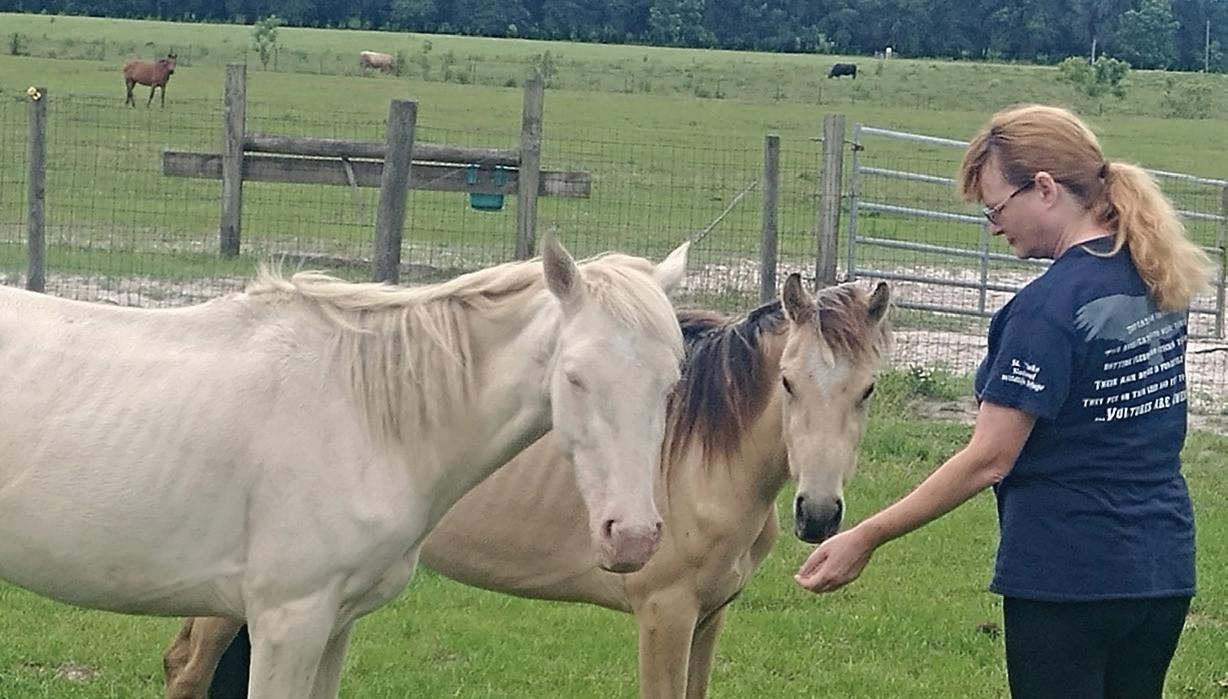
Paul puts it another way.
“The level of vulnerability we have when we have bred our animals into this genetic cul-de-sac becomes hard to escape,” he says. “This is one of those rare instances where an individual can really move the needle just by keeping a flock or herd. It’s a real opportunity for individuals to make a difference in their own backyard.”
The efforts are paying off. Since first establishing the Conservation Priority List 37 years ago, The Livestock Conservancy has not lost a breed to extinction. In fact, in the past dozen years, 12 breeds have “graduated” off the CPL, meaning those animal populations no longer need continual monitoring. In 2024, two breeds—Southdown sheep and Hereford pigs—graduated from the list, and 15 breeds were reclassified within the CPL’s four tiers, most in a positive direction.
For farmers, educators and conservationists, raising and promoting heritage breeds and their products is a labor of love.
More information about these animals and the Conservation Priority List can be found at livestockconservancy.org.



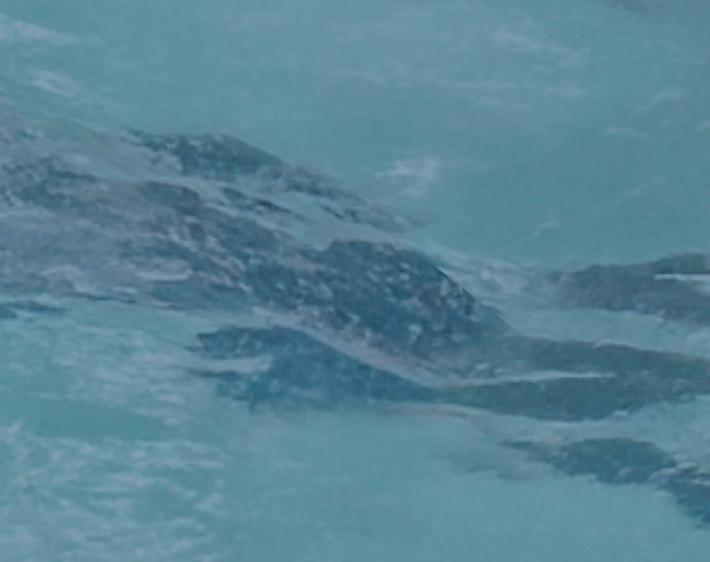
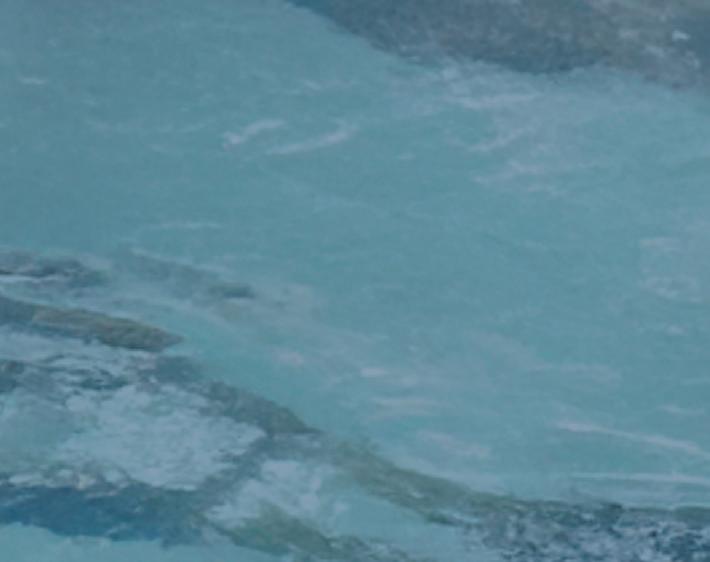





By Theresa Sterling










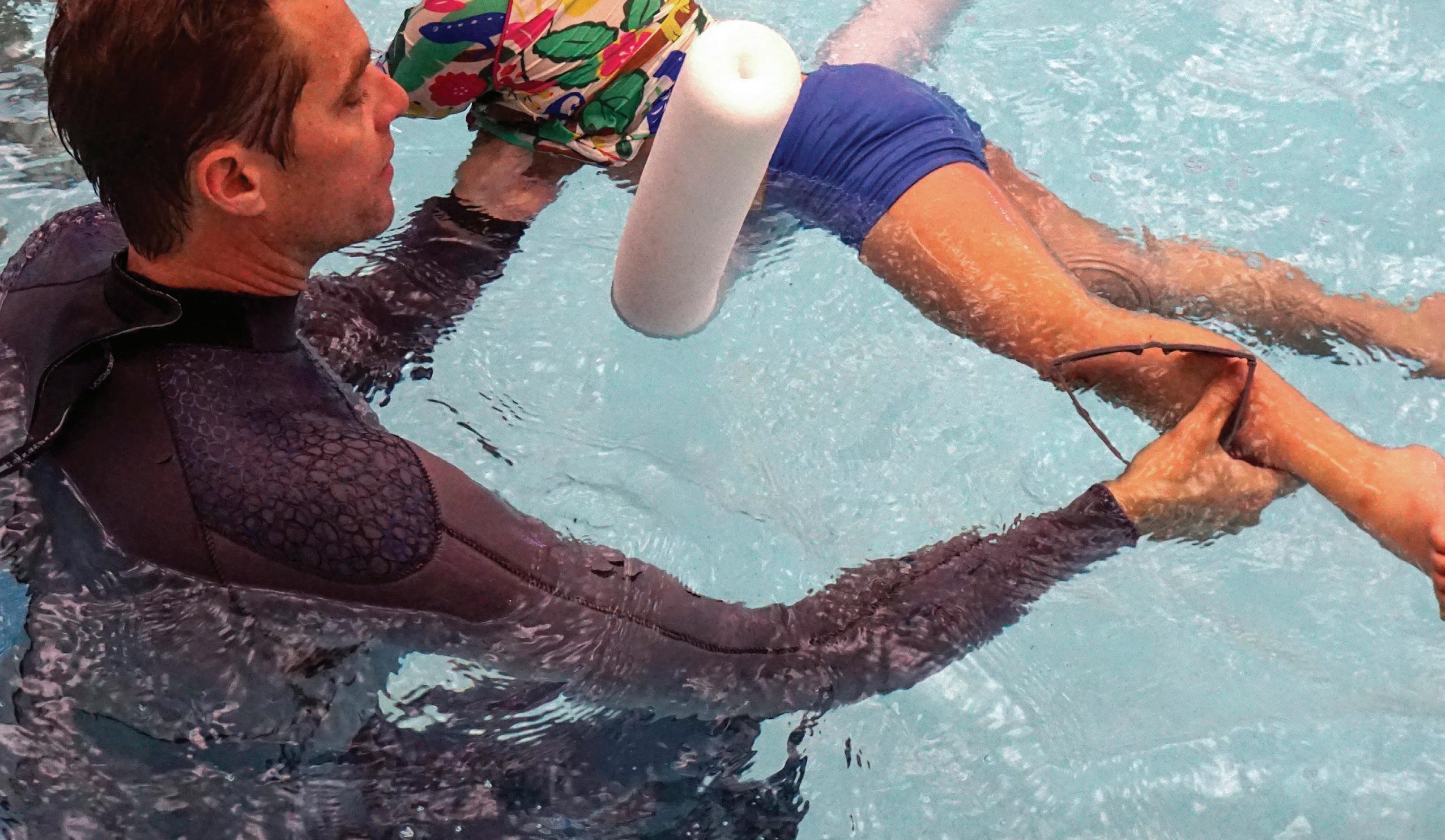



A framed photo from the ’80s shows the sun glinting off Thomas DeCarr Hosford’s dark blonde hair as he sits on the edge of an outdoor pool, supporting a boy who is learning to swim.
Forty years and two knee replacements later, Thomas, who goes by Dickie, is still youthful and agile. He still teaches swimming and coaches the sport. He estimates he’s taught thousands of North Florida children to swim since those first lessons.
“With all of Florida’s shoreline, kids here should all know how to swim,” Dickie says. “If you fall in the water and you don’t know how to swim, you drown. Swimming will save your life. I don’t know of another sport as important or as lifesaving.”
The family’s Hosford Swim School is a Tallahassee institution. It began as a side gig while Dickie worked as a lifeguard and later as a pool manager at Capital City Country Club. Over time, it grew into a gold star swim lesson program open to all of Florida’s Big Bend families.


He later served in Leon County schools for 37 years as a physical education teacher, swim coach and athletic director, all while teaching countless children, starting at age 2, how to swim.
Dickie maintained the pool for the 110-year-old Capital City Country Club, where his father once served as president. Eventually, Dickie’s sons served as lifeguards. His son, Malcolm, 43, now maintains the pool. After working alongside his father for years, Malcolm learned to patch, seal, paint and preserve the pool during dry months. It is an annual labor of love and duty—a new pool would cost the club millions of dollars. It cost $46,000 to build in 1958.
After teaching at the swim school for many years and watching his father coordinate the program the old-fashioned way, Malcolm took over in 2009 while he was studying at Florida State. Now, he runs Hosford Swim School.
“Malcolm really took it to a new level,” Dickie says. “All those years he watched me doing hand mailers, opening stacks of mail with paper registrations and tracking check payments, writing out schedules by hand. He really thought he could grow the school, streamline things and bring us into the 21st century, with social media and all. He really has done that.”

While a member of Florida State University’s swim team, Dickie earned a reputation not only as a competitive athlete but also as someone with a knack for working in the water with children.
Malcolm extended his teaching hours, and his wife, Lena, joined the team in 2013. She manages the swim school’s social media accounts, developed its logo and created a website, which crashed as soon as online registration went live due to the overwhelming volume of sign-ups.



Every season, Hosford Swim School instructors teach 2,000 people. Considering all the years Dickie ran the school on his own, easily 10 or 20 times that number of North Florida children have learned to swim through the Hosford program. They work with young children, teens and college students and have given specific lessons to adults planning to dive for shells on vacation. The waitlist is months long.
Malcolm’s bona fides include high school and NCAA AllAmerican titles, a swimming scholarship to Auburn University and a place on the Florida State University swim team. He was an Olympic Trial qualifier—twice—and coached Georgia’s Thomas University swim team for a few years. When he needed an assistant coach there, he tapped Dickie to join him. His first memory of swimming was with his mom, who gave swimming lessons at her mother’s school, Sutton’s Educational Day Care, in Tallahassee.
Malcolm balances his elite competitor side with a father’s gentle touch while working with young swimmers. He guides goggled heads through side-to-side breathing motions, and just as Dickie used age-appropriate language with the kids—saying “Be a chipmunk” instead of “Hold your breath,” for example, Malcolm does the same.
Student Recreation Center at Florida State University.
Dickie says the way Malcolm works with children comes naturally to him. Malcolm admits he loves kids and especially likes working with the scared ones because he can see their progress.
“I have always been around kids,” he says. “My mom ran a home day care, and my grandmother had the day care in Tallahassee for years. I learned a lot from my grandma because she had the tough love approach. With swimming, you have to bring that to the table because it’s a lifesaving skill before anything else. You have to not let a kid cry their way out of it or let a parent pull them out because they’re crying. It’s just too important.”
These days, Hosford Swim School brings lessons and water safety skills to families in Leon County homes, country clubs and at Leach Recreation Center on the campus of Florida State University in Tallahassee.
Spencer Dalton, a mom of three whose youngest daughter, Reese, 5, is a student at Leach Center, sent her two older children to Hosford Swim School. Spencer, a native Floridian who grew up on the Atlantic Coast, says the peace of mind she and her husband feel, knowing her children learned to swim with Hosford, is invaluable.
“We are a water family,” Spencer says. “We are on our boat on the Gulf, Lake Talquin and the Apalachicola River. It’s important to us that our kids are confident around water, even water that isn’t a pool with steps—water out in nature.”
Peninsular Florida’s general coastline stretches 1,350 miles, and the tidal shoreline—exposed shore boundaries that fluctuate depending on tides—totals 2,276 miles. According to the Centers for Disease Control and Prevention, the state ranked fourth in the United States for unintentional drowning deaths among all ages in 2021, and from 2019 to 2021 ranked the highest in the United States for unintentional drownings among children ages 1 to 4.
Roberta Cooper, Florida native and mom to 4-year-old Savannah, says basic swimming skills and comfort around water are essential for all families with children, whether or not they live near the coast.
“We don’t have a pool at home, but we travel and stay at hotels with pools,” Roberta says. “This is important just for basic safety.”
Austin Hosford, 38, the youngest of Dickie’s four sons, is a Jefferson County commissioner in rural Monticello, just east of Tallahassee, where he lives with his wife, Jessi, and their two children. Austin was a lifeguard at Capital City Country Club at age 16 and taught at the swim school, too.
Holding their 2-year-old son, Barrett, by the pool in their backyard, Jessi wondered aloud if the toddler is too young to start swim lessons this summer. Dickie gave professional advice and a strong grandfatherly opinion.
“With a pool in your backyard,” he said, “this summer he has to either learn respect for the pool or learn how to swim.”
What Dickie is most proud of, he says, is teaching so many kids the lifesaving skill of swimming, of opening doors for them to all the other water sports they may want to do. They are, after all, Floridians.
Learn more about Hosford Swim School at hosfordswimschool.org.

Drownings are one of the leading causes of child deaths in the state, according to the Florida Department of Children and Families. The agency offers key tips for keeping children safe in and near the water.

Never go near the water without an adult. It’s important for young children to know the fun can’t begin until a “water watcher” is present. Drowning can happen quickly and quietly, so someone keeping an eye on swimmers is a necessity. Make sure your child knows never to go near the water alone and always to have a swimming partner. Install barriers around your pool or hot tub, and remove any pool toys that could attract children to the water.
Wear a life jacket. Always wear a life jacket while in a boat, raft, inner tube or on a dock. If a child cannot swim or is an inexperienced swimmer, use a life jacket while in the water. Fit the jacket to keep the child’s head and face above water. Remember, life jackets only work when they are worn, so make sure your children get in the routine of putting one on every time they get near the water. Water wings and inflatable toys don’t provide the same support as a U.S. Coast Guardapproved life jacket.



Learn to swim. Swimming lessons can reduce drowning incidents, which is why the American Academy of Pediatrics recommends children 4 and older learn to swim. Even if your child has taken swimming lessons, never assume their risk of drowning is over. To find swimming lessons in your area, contact your area YMCA, American Red Cross, American Heart Association, city facilities or a local swim school














Easy Pepperoni Pizza Quesadillas
2 8-inch flour tortillas
2 tablespoons tomato sauce (may substitute spaghetti, pizza or marinara sauce)
10 to 12 slices pepperoni


6 to 8 tablespoons shredded mozzarella cheese
Butter
Additional tomato sauce
Spread tomato sauce evenly over entire tortilla in a thin layer. Add pepperoni, covering half of each tortilla.
Sprinkle the pepperoni with a layer of cheese. Fold over the top of the tortilla. Melt a bit of butter in a skillet. Place two quesadillas in the skillet. Cook 2 to 3 minutes over medium heat until lightly browned.



While the first side of the quesadilla is cooking, lightly butter the other side of each tortilla. Flip over the tortillas, and cook until the second side is browned. Remove the quesadillas from the pan. Let rest for a few minutes, then slice each tortilla into quarters or thirds. Serve with warm tomato sauce for dipping.

8 ounces cream cheese, softened
½ cup sour cream
¼ cup picante sauce
2 tablespoons taco seasoning
Dash garlic powder
4.5-ounce can chopped olives, drained
4-ounce can chopped green chiles
1 cup finely shredded cheddar cheese
½ cup thinly sliced green onions
8 10-inch flour tortillas, warmed
Salsa
In a small bowl, beat together cream cheese, sour cream, picante sauce, taco seasoning and garlic powder until smooth. Stir in olives, chiles, cheese and onions. Spread about ½ cup on each tortilla. Roll up jelly-roll style.
Cover. Refrigerate for at least 2 hours. Slice into 1-inch pieces before serving with salsa.
Taco Lasagna Recipe
2 tablespoons olive oil, divided
1 pound lean ground beef
1 medium yellow onion, diced
1 medium red bell pepper, cored, seeded and diced
2 cloves garlic, minced
15-ounce can black beans, drained and rinsed
1 tablespoon chili powder
2 teaspoons ground cumin
1 teaspoon dried oregano
1 teaspoon kosher salt
¼ teaspoon freshly ground black pepper
16-ounce jar salsa, divided
12 8-inch corn or flour tortillas, divided
16 ounces sour cream, divided
16 ounces shredded Mexican cheese blend, divided
Heat oven to 350 F. Arrange a rack in the middle of the oven. Heat 1 tablespoon of oil in a large, high-sided skillet over medium-high heat until shimmering. Add ground beef. Cook, breaking up the meat with a wooden spoon, until browned and cooked through, 6 to 8 minutes. Using a slotted spoon, transfer the meat to a plate. Pour off any fat from the skillet.
Reduce heat to medium. Add the remaining olive oil. Heat until shimmering. Add the onion, bell pepper and garlic. Cook, stirring occasionally, until softened, about 5 minutes. Return the beef and any juices to the skillet. Add black beans, and stir to combine. Add chili powder, cumin, oregano, salt and black pepper. Stir to combine. Cook for 2 minutes.
Remove the skillet from the heat. Pour ¼ cup salsa into a 9-by-13 baking dish. Pour the remaining salsa into the skillet. Stir to combine.
To assemble the lasagna, spread out the salsa in the baking dish into a thin layer. Arrange four tortillas in a single layer on top of the salsa, overlapping them as needed. Dollop and spread ⅔ cup of the sour cream. Spoon half of the meat mixture over the sour cream. Spread in an even layer. Sprinkle with 1⅓ cups of cheese.
Repeat layering the following: four tortillas, ⅔ cup sour cream, the remaining meat mixture and 1⅓ cups shredded cheese. Top with the remaining four tortillas and ⅔ cup sour cream. Sprinkle with the remaining 1⅓ cups cheese.
Bake, uncovered, until the cheese is melted and lightly browned, about 30 minutes. Cool for 15 minutes before serving.
3 tablespoons butter
3 tablespoons all-purpose flour
2 cups chicken broth
1½ teaspoons chili powder
¼ teaspoon oregano
¾ teaspoon salt
¼ teaspoon black pepper
1 pound boneless, skinless chicken breasts, diced
1 cup sour cream
6 to 7 regular-sized flour tortillas, cut into bitesized pieces
7.5 ounces black beans, drained
14.5-ounce can diced tomatoes, drained
1 cup shredded cheese
In a large skillet, heat butter until melted. Stir in flour, and cook for 1 minute. Whisk in chicken broth. Stir until sauce is smooth and thickened, about 2 to 3 minutes. Stir chili powder, oregano, salt and pepper into the sauce.
Add chicken breasts to the pan. Bring to a simmer, then reduce heat to low. Cover and cook for about 15 minutes, until chicken is cooked through. Remove chicken from the pan, and shred into bite-sized pieces.
Stir sour cream into the sauce. Return the chicken to the skillet. Add tortilla pieces, black beans and tomatoes. Stir until combined, then top with shredded cheese.
Cover skillet and cook until bubbly and the cheese is melted, about 5 to 8 minutes.
1¼ pounds lean ground beef
¼ cup finely chopped onion
1¼ cups salsa
2 tablespoons taco seasoning
½ cup water
2 15-ounce cans pinto beans, rinsed and drained
2 cups shredded cheddar cheese
12 8-inch flour tortillas, warmed
In a large skillet, cook beef and onion over medium heat until meat is no longer pink, about 5 to 7 minutes, breaking meat into crumbles. Drain. Stir in salsa and taco seasoning. Bring to a boil. Reduce heat. Simmer, uncovered, for 2 to 3 minutes. Transfer to a large bowl, then set aside.
In a food processor, combine water and beans. Cover. Process until almost smooth. Add to beef, and stir in cheese.
Spoon ½ cup beef mixture down the center of each tortilla. Fold ends and sides over filling. Roll up. Wrap each burrito in waxed paper and foil. Freeze for up to 1 month.
To heat frozen burritos: Remove foil and waxed paper. Place one burrito on a microwave-safe plate. Microwave on high until a thermometer reads 165 F, about 3 minutes, turning burrito over once. Let stand for 20 seconds.
By Dave LaBelle
There are annual events—such as birthdays, anniversaries and holidays—many of us are determined to make pictures of.
One of the annual events I am often called on to photograph is fireworks during the Fourth of July. Here is where I confess, even though I have photographed fireworks for more than a half a century, I never seem to capture the picture I want.
Oh, I have made some acceptable pictures through the years but not one that I felt expressed what I saw and felt.
I surveyed the grounds early where the fireworks were to be launched this past year, seeking every possible angle.
Some cities have hilltops or big rivers running through them, like Pittsburgh or Portland, Oregon. But Dyersville, Iowa, is flat with few bumps we might dare to call hills.
Finally, I decided on a low, grassy spot that afforded a relatively clean, uncluttered view of the aerial bursts. However, as parking spaces grew thin, vehicles lunged forward, parking on the grassy spot I had

chosen. Camera and tripod in hand, I had to move or get run over.
Just as I was about to seek another last-minute vantage point, a couple of children put down a blanket between two vehicles and sat waiting for the show.
Hmmm?
If I could get low enough, they might make a good foreground, their shapes against
a lit-up sky.
I moved up slowly and stealthily behind them and lay on the ground to see if I could get the camera low enough— off the tripod—to see if I had enough sky to see and capture fireworks once they began.
At one point—still 30 minutes before the show—I had to explain to their father, watching me suspiciously, the photo I was hoping to capture.
Determine to make a beautiful photograph that captures the spirit of celebration meant by filling the sky with beautiful explosions of color and design. Scout areas and choose the spot first. Then consider using a tripod and slower shutter speed. To create depth and context, foreground is key. Above all, experiment with exposure. Each burst is often a different color and intensity.
Email your best image (just one) with caption information, including an explanation of how it affects you, to gph@pioneer.coop. We may share submissions on our website and social media channels.
As most of you who have attempted to photograph fireworks know, there is a lot of luck involved. That acknowledged, the old maxim, “Luck is where opportunity meets preparation,” was on my side this evening.
After a handful of lowbursting blasts, finally a reddishpink explosion filled the sky low enough to wash over and even reflect on the parked vehicles. n

more of his writings, visit davidlabelle.com and his blog at bridgesandangels.wordpress.com.
If you suspect you’re dealing with a utility scam, it’s crucial to slow down and take your time before taking any action.
Scammers will often pressure you to make quick decisions or immediate payments. Instead, take the time to verify the legitimacy of the communication by contacting your utility directly.
Use a phone number from a reliable source, such as your bill or the utility’s website. Taking this simple step can help protect you from falling victim to utility scams.
Source: Utilities United Against Scams

The Florida Panhandle offers a beautiful setting and many diverse fishing opportunities. A top angling destination, St. Andrew Bay covers approximately 25,000 acres near Panama City Beach.
“Probably one of the biggest draws to this area is that we have so many different fishing options,” says Justin Leake with Panama City Inshore and host of “Chasin’ the Sun” on the Discovery Channel.
“Summer is probably the most versatile time to fish this area.”
The very salty and clear sparkling waters provide excellent sight-fishing for redfish and other species. People can also catch speckled trout, flounder and other saltwater fish. Anglers without boats wade the pristine beaches.
“In June, we catch redfish around the bridges and passes with a variety of artificials,” Justin says. “We catch bull reds with live bait. The early-morning topwater bite is really good for speckled trout and redfish. After the redfish action slacks off, we move out deeper and throw jigs for trout.”
Florida excels at tarpon action. The Panama City Beach area once held the state record for tarpon and still delivers some giants exceeding 200 pounds. In the summer, tarpon chase baitfish in shallow water close to the beaches.
“My No. 1 go-to summer activity is tarpon fishing,” Justin says. “The tarpon are mostly migrating along the beaches
where we sight fish them with live bait or swimbaits. Their backs are relatively dark, so they really stand out in that emerald green clear water.”
Anglers watch for tarpon to roll on the surface and then toss live baits or lures to them. Silver kings bite just about anything that resembles a baitfish. Many people fish for tarpon with fly tackle.
“Tarpon will eat anything that looks like an easy meal,” Justin says.
People can find mangrove snapper and sheepshead around hard structures. For mangroves, use live shrimp or baitfish. For fast action, fish for bluefish and Spanish mackerel around grass flats near the pass. These toothy predators will attack anything shiny that mimics a baitfish.
Larger boats head offshore to fish for red snapper, grouper and other fish during the summer. Depending on the location and water depth, anglers might also catch king mackerel, cobia, dolphin—also called mahi—wahoo, tuna, sailfish or blue marlin.
“Offshore, we go for red snapper and king mackerel in June,” Justin says. “We catch snapper from 60 to 200 feet of water. Any live or dead bait will work. King mackerel hang around the buoys and reefs looking for bait concentrations.”
Those fishing with a Florida licensed charter captain do not need a state fishing license. People can enjoy other recreational activities commonly associated with beach
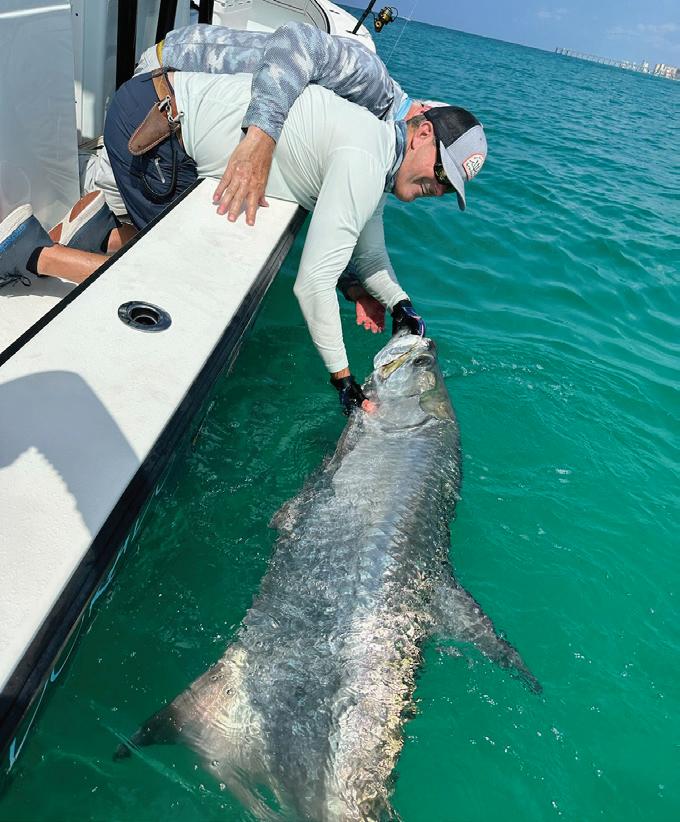
PHOTOS
communities. For seafood, try the Grand Marlin or Capt. Anderson’s in Panama City Beach. I recommend staying at Sheraton Panama City Beach Golf & Spa Resort. n
For more information, visit destinationpanamacity.com or visitpanamacitybeach.com. For more about Panama City Inshore Fishing, call 850-258-7780 or visit panamacityinshore.com.

John N. Felsher is a freelance writer, broadcaster, photographer and editor. He’s written more than 3,500 articles on a wide variety of outdoor topics. Contact him at j.felsher@hotmail.com or through Facebook.






































All ages can find something new and exciting around every corner of the state. Filled with rich history, abundant natural beauty and diverse events all year, Florida has something fun for everyone.
June 1-20
Summer Solstice Celebration
Join us at Mallory Square for 20 evenings this June as we celebrate the summer solstice. Participants consist of arts and crafts exhibitors, psychics, street performers, food carts, and thousands of tourists who visit this art show. Each night, one hour before sunset, locals and tourists flock to the water’s edge to experience a multicultural happening and watch the sun sink into the Gulf.
www.sunsetcelebration.org; 305-396-7046


June 3
Nature Through The Looking Glass
Join a ranger at the Gator Lake Overlook to try and spot American alligators, bald eagles, various wading birds and other species native to the state of Florida. Spotting scopes and binoculars are provided. Parking for the Gator Lake overlook is on the main park loop. bit.ly/43meDnd; 850-245-2157
June 5
Truman Waterfront Farmers Market
Shop with a view 2-7 p.m. every Thursday at the Truman Waterfront Farmers Market on the harbor by the U.S. Coast Guard Cutter Ingham Maritime Museum. Find food, including ready-to-eat items, fresh Florida produce and other grocery items, alongside gifts, home decor, art and more.
keysartisanmarket.com; 305-731-3385

June 7
Palafox Market
Find one-of-a-kind, precious and offbeat items, and delicious goods, originating from on-site vendors. Join us from 9 a.m. to 2 p.m. every Saturday, rain or shine, for farm-fresh produce, plants, flowers, baked goods, works of art, fresh tea and coffee, food and spices, hand-blown glass, and ceramics. downtownpensacola.com/palafox/palafox-market; 850-380-8196

June 7
Into the Woods: Artist’s and Farmer’s Marketplace Neighbors, friends and family are invited to the inaugural Artist’s and Farmer’s Marketplace. This 6-acre property is a thriving hub of honeybees, vegetables and pottery, making it the perfect destination for artisans, farmers, makers and bakers. Join us in exploring exceptional products from talented creators while enjoying the peaceful surroundings. 850-679-4750
June 7
History Tour
Join in a guided tour of Camp Helen State Park. Staff share park history from the Hicks family building to the colorful history of Avondale Mills using the property as its employee vacation retreat. Gather at 10 a.m. at the visitors center/park office and dress appropriately for the weather. Park admission is $4 per vehicle, $2 per pedestrian or bicycle in the honor box at the entrance or via the QR code on the entry sign. www.floridastateparks.org/events/history-tour-35; 850-245-2157


June 5
16th Annual UF/IFAS Range
Cattle REC Youth Field Day
The goal of this event is to excite students about agriculture and science and foster a love of learning. Students 8 to 18 years old earn a Youth Beef Quality Assurance Certification. This year’s classes are Biosecurity: Lowering the Exposure; Nutrition and Body Condition Scoring; Newborn Calf Health Management; Low-Stress Cattle Handling; and Best Practices: Using Injectables. General registration is open until June 3 for $25. rcrec-2025-yfd.eventbrite.com; 863-735-1001






June 7
Centennial/Sesquicentennial Festival
Join us 9 a.m. to 3 p.m. for a fun, family-friendly event in honor of Wewahitchka’s 150th and Gulf County’s 100th birthdays. There are food vendors, arts and crafts booths, children’s activities, live music, and library exhibits and speakers. Special events include a Wewa settlers costume contest and an antique car show. Sponsored by the Friends of the Wewahitchka Library, the Wewahitchka Historical Society and the City of Wewahitchka, the event is free and open to the public. www.facebook.com/profile.php?id=61572259151675; 850-639-2419
June 14


College of the Florida Keys Swim Around Key West Embark on an adventurous competitive swim—a 12.5-mile loop around the island. The pristine waters around Key West give swimmers great views of the land and underwater life. Compete in categories, such as solo swimmer, solo swimmers with fins, solo swimmers using a mermaid tail or a monofin, or gather your friends and compete in the relay category of two-, three-, four-, five- or six-person teams. Not interested in the full island swim? Try some of the other races offered: the 6.1-, 2- or 1-mile swims, or an 800-yard swim. Swims begin and end at Higgs Beach, 1000 Atlantic Blvd. swimaroundkeywest.org; 305-809-3562
June 19
Juneteenth at Five Sisters’ Blues Cafe Juneteenth is the oldest nationally celebrated commemoration of the ending of slavery in the United States. On June 19, 1865, Union soldiers landed in Galveston, Texas, with news that the war had ended and the enslaved were free. Juneteenth meals feature foods connecting cooking traditions of the African diaspora. African American pit masters display their barbecue alongside other dishes, such as greens and black-eyed peas, that represented prosperity and good fortune. Summer fruits and flowers in shades of red are a special highlight during Juneteenth. It is with this in mind that Five Sisters’ chef Josh Rich is once again offering a selection of Juneteenth adaptations to honor African American contributions to America’s culinary tradition and celebrating Juneteenth. fivesistersbluescafe.com; 850-912-4856
June 28
Generations of Strength Street Fair and Dance Party




This joyous event in the 700 to 1,000 blocks of Duval Street is the heart of Pride festivities, showcasing a mix of performances, eclectic vendors and diverse community spirit. With more than 50 vendors, you’ll discover an array of unique crafts, delicious food and informative booths. The party doesn’t stop there. Join the dance floor for live performances. Whether you’re exploring the fair or dancing with friends, this event promises an unforgettable experience of unity and celebration. All are welcome at this family-friendly event. gaykeywestfl.com/pride; 800-535-7797

June 13-14
Watermelon Festival
Get ready to relive the sweetest moments of the past while making juicy new memories. We’re celebrating decades of watermelon magic—from groovy events to nostalgic festival traditions that have stood the test of time. Whether you’re rocking your best vintage vibes or embracing the modern melon moment, join us as we honor the generations who have made this festival a summertime staple. It’s time to taste the tradition, dance through the decades and celebrate your Watermelon Era. The festival is 3-9 p.m. Friday and 9 a.m. to 3 p.m. Saturday. www.monticellowatermelonfestival.com; 850-997-5552

Want to share a family-friendly event with the readers of Florida Currents? Head online and enter the details at tinyurl.com/FloridaCurrents or use the QR code for easy access. Make sure to submit the item at least 60 days before the event (due to press deadline). If you own rights to a print-quality photo promoting your event, include it with photo credit information.




When it comes to managing pests in the garden, pesticides often seem like a quick and effective solution. However, overreliance on them can lead to pesticide resistance and potentially harm increasingly fragile ecosystems. That’s where natural enemies can come into play. Certain insects act as nature’s pest control.
Predators such as lacewings, lady beetles, minute pirate bugs, big-eyed bugs, syrphid flies and praying mantis, alongside parasitoids such as tachinid flies and parasitoid wasps, help maintain balance in the landscape by feeding on pests or laying their eggs inside or on them.
Supporting these beneficial insects ensures we rely less on chemicals and more on nature’s own pest control mechanisms. One of the best ways to support these garden allies is by creating an environment rich in plant diversity.
In regions such as Central Florida where year-round blooms are possible, maintaining a continuous supply of flowering plants ensures beneficial insects can thrive throughout the year.
A variety of culinary herbs that help predators can be incorporated into the landscape, including dill, cilantro, spearmint, peppermint, parsley, thyme, fennel, basil, lemon balm, catnip and horsemint/bee balm.
Wildflowers and ornamentals provide nectar and pollen, key resources for adult foraging insects. That includes echinacea, yarrow, zinnia, calendula, goldenrod, chamomile, rouge plant, coreopsis, porterweed, gaillardia, liatris, cosmos, sweet alyssum, rattelsnake master, rudbeckia and Stokes’ aster.
Woody perennials and trees should not be overlooked as they offer shelter and food. Among them are oak species, holly species, Simpson’s stopper, Chickasaw plum, crape myrtle, button bush, Walter’s viburnum and fire bush.
Native bunch grasses are also essential, offering refuge for reproductive insects to lay their eggs and raise their young.

Some common native species of bunch grasses include Elliot’s love, purple love, Florida gama, lopsided indian, muhly and Fakahatchee.
Minimizing disturbances is equally important for fostering natural enemies in the garden. Before reaching for a pesticide, start by scouting your garden and identifying the pest.
Florida alone is home to more than 12,500 insect species. Of this incredible diversity of species, less than 3% are actually considered pests, so proper identification is key. Simple hand removal or physical methods are often effective for many insect pests.
If chemical intervention becomes necessary, choose nontoxic or less-toxic options, such as microbial insecticides, horticultural oils and soaps. Avoid applying pesticides when plants are in bloom, and

opt for targeted chemistries and mindful applications as a last resort.
Finally, rethinking how landscapes are managed can make a big difference. Reducing mowing, tilling and debris removal allows beneficial insects—especially those that live in leaf litter or hollow plant stems—to establish stable populations.
A slightly wilder, less manicured garden can be a haven for these natural enemies, giving them the time and space to do their part in maintaining a healthy, balanced ecosystem.
By embracing this approach, we can cultivate a garden that supports beneficial insects and leads to more sustainable pest management overall.
Find native and Florida-Friendly plants in your area by visiting Florida Association of Native Nurseries and BetRock’s Plant Finder.
Dr. Heather Kalaman serves as the Florida-Friendly landscaping horticulture agent for UF/IFAS Extension Orange County. She is a graduate of the UF Doctor of Plant Medicine Program and has a master’s degree in environmental horticulture, where her research focused on pollinator-plant interactions. Her passions and programing are focused on sustainable landscaping practices.


For year-round outdoor lighting of yards, driveways, walkways, roads, and other areas, FKEC offers two LED outdoor lighting options to our members. The lights are electrically connected so that the power for the operation of the light does not pass through the member’s electric meter. Instead, the monthly charge is based on the calculated kilowatt-hours (kWh’s) used per lamp, depending on its size. Each light contains a photocell that automatically turns on at dusk and off at dawn.
New outdoor lights are installed on existing FKEC distribution facilities only (no meter poles); however, the presence





of a pole does not guarantee it is capable of a light installation. Our engineering personnel will make the determination.
For more information on obtaining an outdoor lighting fixture, visit the Account section at www.FKEC.com or call 305-852-2431.
Have a problem with an outdoor light?
If you are aware of an inoperative or malfunctioning outdoor light operated by FKEC, please call the co-op at 305-852-2431 or 800-858-8845 to report
it. Printed in compliance with Florida Statute 768.1382. When reporting the problem, please have the following information available:
• The specific street address where the light is located.
• A description of where the light is located on the property.
• A description of the problem.
• Your contact information, including name, address, and telephone number. ■
Section 252.355(2)(d) of the Florida Statutes mandates that each electric utility in Florida must notify residential customers in its service area annually, on or before May 31st, about the special needs registration program available through their local emergency management agency.
The registry is a planning tool to allow citizens with special needs the opportunity to provide information to local emergency response agencies, so emergency responders can better plan to serve them in a disaster.
FKEC wants to make sure all our members are aware of this service and encourages you to learn more about the registry before a storm strikes. Learn more about this county service by calling 305-292-4591 or visiting www.monroecounty-fl.gov/148/Special-Needs-Registry.
Please note, this service is offered through Monroe County Emergency Management and is independent of FKEC.








By Miranda Boutelle
Q: What does “beat the peak” mean, and why should I care about it?
A: When utilities talk about “beat the peak,” it’s a call to action for energy consumers to reduce electricity use during periods of highest demand. Using less energy during peak times can ease the strain on the electric grid, benefit your electric co-op and sometimes lower your electric bill.
Electricity generation and energy supply must match consumption in real time to ensure safe, reliable power. Every moment of every day, an entire workforce monitors energy use, adjusting power plant production up or down as needed to keep the grid balanced.
As energy demand grows, we can all do our part to use less. To put this in perspective, peak electricity demand is expected to increase by 38 gigawatts over the next five years, according to the Energy Information Administration. That’s like adding another California to our nation’s power grid.
Peak times vary for each utility, but in the Florida Keys, they typically occur in the afternoon and early evening, when air conditioners work hardest to keep homes cool and families return home for dinner and evening activities.
Typically, the price of power increases when demand is higher. Reducing your electric use during peak times can help lower market prices for everyone and lessen stress on the electric grid.
Electric utilities set electricity rates to cover costs. Some utilities have time-of-use rates that reflect higher costs during peak demand periods.
Whether they have time-of-use rates or not, these tips can help keep costs down for your utility and establish off-peak energy habits:
As a general rule, try to spread out your use of equipment and appliances. For example, I avoid cooking while also washing dishes and clothes. Running a lot of hot water causes your water heater to use more energy, too.
Increasing the energy efficiency of your home can lower its impact on the grid. Weatherize windows and doors, and add insulation to improve the comfort of your home. You can also consider upgrading to energy-efficient appliances or using







energy-saving features on your existing appliances.
If you haven’t already, switch your incandescent lighting to LEDs, which use at least 75% less electricity and last up to 25 times longer, according to the U.S. Department of Energy. There are many affordable options on the market.
Schedule your dishwasher run time. My dishwasher, which is several years old, has a “delay start” button. This is also handy if your dishwasher is loud. Setting it to start after you go to bed shifts that energy consumption to off-peak hours, and you don’t have to hear it.
Running your washing machine and dryer during nonpeak hours can help, too. If you’re in the market for a new washer or dryer, look for a model with a high Integrated Modified Energy Factor and a low Integrated Water Factor to save water and energy.
Also, consider switching your charging habits for all devices to off-peak hours. If you have an electric vehicle, use the scheduled charge settings. Plug in your vehicle when you get home, and it starts charging automatically during the off-peak hours you choose.
Small changes at home can make a big difference to the energy grid. Incorporate these energy-wise habits into your daily routine to help keep power reliable in the Keys.


Don’t take the power of electricity for granted
Electricity and water are a dangerous—potentially fatal—combination.
Swimmers and boat owners need to take precautions to make sure their time in and on the water is safe. While this might seem like common sense, boats and docks are often powered by electricity. One mistake could lead to tragedy. Consider the following points:
• There is no visible warning to electrified water. Electric current in water causes a paralysis of muscles, which can result in drowning. As little as 10 milliamps—1/50 of the amount used by a 60watt light bulb—can cause paralysis.
• If you are in or on the water and feel a tingling, the water might be electrified. Immediately get out of the water. Avoid using metal objects, such as a ladder. Alert others who are in the water to try to stay upright, tuck legs to be smaller and swim away from anything that could be energized.
• If you believe an electric shock drowning is occurring, turn off all power, throw a life ring to the person, and call 911. Do not enter the water. It could still be electrified.
• If you own a dock or pier, install ground-fault circuit interrupters, and test them monthly. Use portable UL-Marine List GFCIs when using electricity near water.
• If you own a boat that uses electricity, install equipment leakage circuit interrupters to protect swimmers from electric shock in the water around the boat. The Energy Education Council recommends all electrical installations be performed by a professional electrical contractor familiar with marine codes and standards. The organization also recommends individuals not swim around docks with electrical equipment or boats plugged into shore power. Many electrical shock drowning deaths have occurred around private docks and boats plugged into shore power while docked.
Cut your bills
By Christina Sawyer
Summer in Florida means sunshine, heat and, oftentimes, higher energy bills. But simple weekend projects can help you cut costs and stay comfortable while easing the demand on the power grid.
Sustainability is a bonus, but you’ll notice the biggest impact in your wallet. So, roll up your sleeves and dive into these DIY energy-saving projects.
LED lights are far more energy-efficient than traditional bulbs and last significantly longer. Swapping out your old bulbs for LED equivalents is a simple and effective way to lower your energy consumption.
Spend some time this weekend replacing bulbs throughout your home, and watch your energy bills shrink over time.

Did you know air leaks around doors and windows can significantly increase your home’s heating and cooling loss? But fret not, because sealing these leaks is a quick

fix that yields tangible results.
Grab a caulking gun and some weatherstripping, and get to work sealing any gaps. This helps your air conditioning work less, prevents your hard-earned money from seeping out through cracks and keeps your home cooler.
We’re all guilty of leaving electronics plugged in when they’re not in use. Even in standby mode, these devices still draw power. This phenomenon, known as standby power or phantom load, can account for up to 10% of your home’s energy use.
Spend some time this weekend unplugging unused devices or investing in smart power strips that automatically cut power to devices when they’re not in use.

During Florida summers and even fall, air conditioning is essential. Your HVAC system works overtime during these


seasons to keep your home comfortable. But like any piece of machinery, it requires regular maintenance to perform optimally. Spend a weekend changing filters, cleaning vents and scheduling a professional tuneup. Not only will this improve your system’s efficiency, it will also extend its lifespan, saving money in the long run.
In today’s digital age, there’s a smart solution for just about everything— including energy management. Consider investing in a smart thermostat that learns your habits and adjusts your home’s temperature accordingly. Pair this with smart plugs, lights and appliances, and you’ll have complete control over your home’s energy consumption at your fingertips.


Before diving headfirst into the world of smart home technology, it’s crucial to ensure your home’s electrical
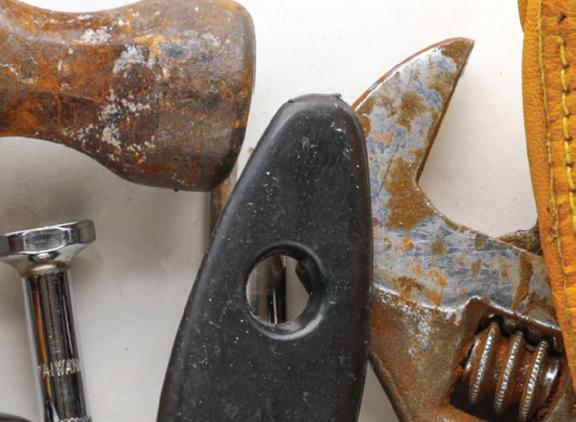









system is up to the challenge. Here are a few steps you can take to prepare:
• Start by inspecting your home’s electrical panel. Determine its age, capacity and condition. If your panel is outdated or overloaded, it may struggle to accommodate the additional load from smart devices. Consult with a licensed electrician to assess whether an upgrade is necessary.
• Inspect the wiring throughout your home to ensure it’s in good condition. Look for signs of wear and tear, such as frayed insulation or loose connections.
If you have older wiring, such as knoband-tube or aluminum wiring, it may not be suitable for modern smart devices. In such cases, rewiring or retrofitting may be required for safe compatibility.


• If your home still has traditional outlets and switches, consider upgrading to smart-compatible versions. Smart outlets and switches offer added functionality and convenience, allowing you to control lights,


appliances and other devices remotely. Just be sure to follow manufacturer guidelines and consult with a professional if you’re unsure about installation.
By taking the time to assess and prepare your home’s electrical system, you can ensure a smooth and seamless transition to smart home technology. With the right infrastructure in place, you’ll be ready to embrace the convenience, efficiency and innovation smart devices have to offer.
When it comes to landscaping for energy efficiency, planting trees can make a world of difference. By planting trees, shrubs and vines strategically around your home, you can create natural barriers that provide shade in the summer and act as a windbreak in the winter.

Spend a weekend mapping out your landscaping plan, considering factors such as sun exposure, wind



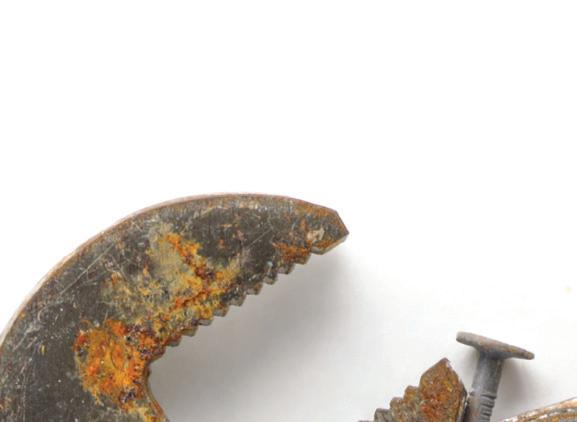

existing structures. With a little foresight and planning, you can create a green oasis that enhances your home’s energy efficiency and adds value and curb appeal. Remember to avoid planting trees directly under power lines, as this can lead to potential hazards and costly maintenance issues down the road. Before you start digging, call 811 to have underground utility lines marked. This simple step can prevent accidents and ensure a smooth and safe planting process. By implementing simple measures such as switching to LED lighting, installing programmable thermostats or sealing leaks, homeowners and renters can lower their energy consumption and save money. Armed with new knowledge, you can become a weekend warrior, save money and make a difference, one project at a time.




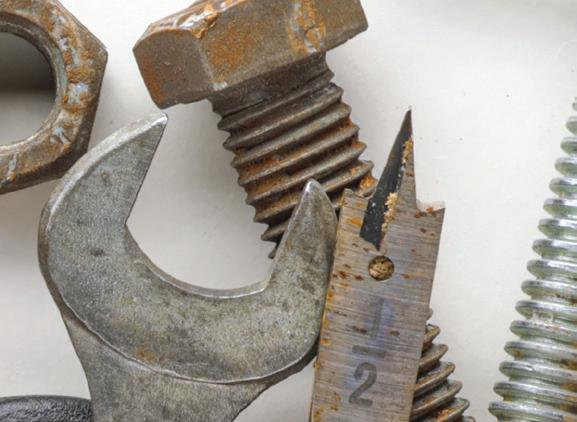


From babies and young animals to adults of all ages, Florida is filled with beautiful faces. The expressions you capture have a chance to brighten others’ days.
From time to time, we share some readers’ photos in this space. If we use your photo here, we will send you your choice of a $25 gift card to REI or Amazon.
To submit your photo, email a JPEG file to photos@ floridacurrents.com. Include “Before You Go” in the subject line. Please share a bit about what inspired you to make your photo.

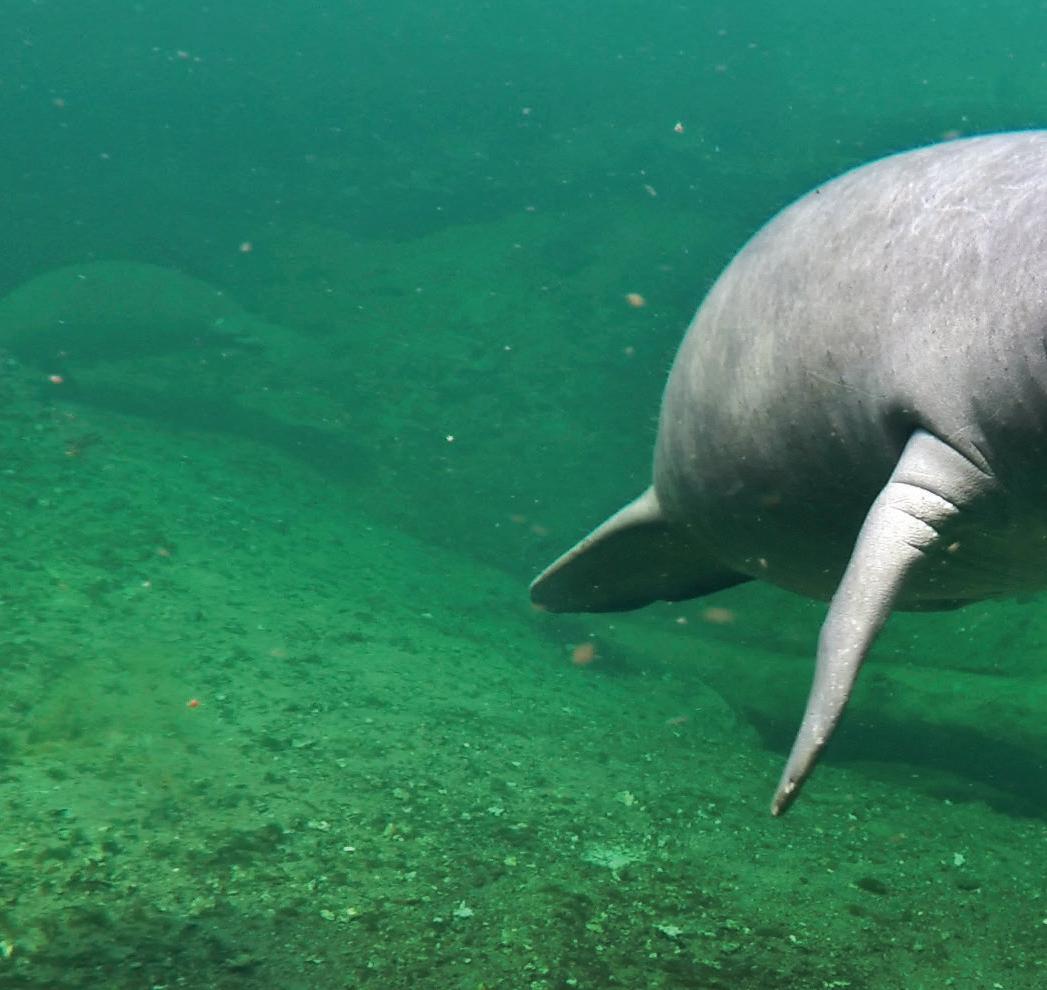

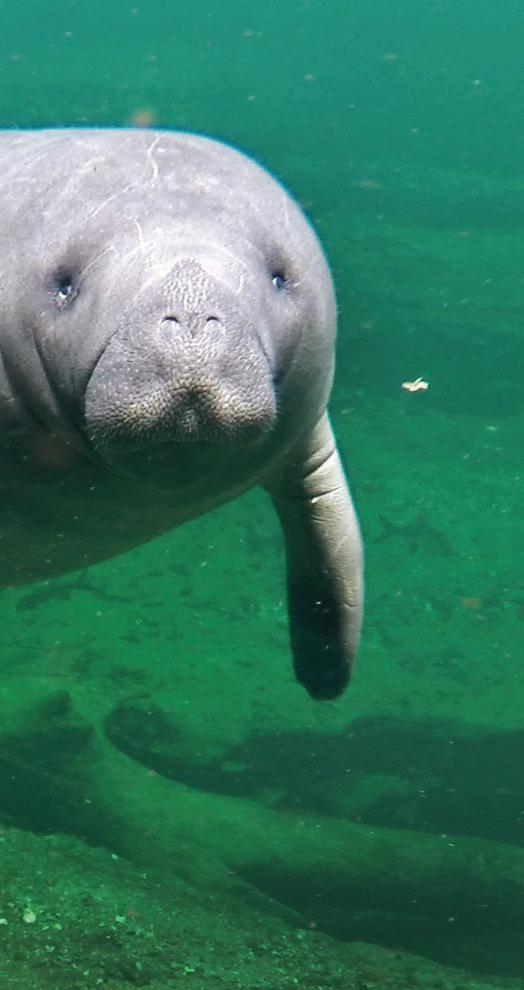


the greatest national parks of America’s Southwest!—Book
Welcome to a great vacation at an affordable price. These quality tours feature complete sightseeing, professional Tour Directors, and great itineraries. Discover for yourself why smart shoppers and experienced travelers have chosen Caravan Tours since 1952.
See the greatest national parks of America’s Southwest! You’ll enjoy 2 nights in national park lodges near the South Rim of the Grand Canyon, 2 nights at Lake Powell Resort, and 2 nights near Zion National Park.
The #1 in value. Your Grand Canyon, Bryce & Zion tour is fully guided with all hotels, activities, and some meals. You’ll explore Grand Canyon, Bryce, Zion, Lake Powell, Monument Valley, Antelope Slot Canyon, Sedona, and more!—Book now for choice dates:

Scan for Grand Canyon, Bryce & Zion 8-Day Tour $2195
Enjoy complete sightseeing with more visits, extra features, and local guides. Caravan includes all activities listed in the tour itinerary. Caravan does not sell any optional activities which can add hundreds of dollars to your tour price. Your free time is scheduled in great settings where there is no need to buy additional expensive activities.
Our 73rd year of excellence. Caravan has operated fully guided tours of superb value under the same family management and ownership since 1952.
“Brilliant, Affordable Pricing” Arthur
Frommer, Travel Editor


Receive your bill electronically by going paperless.
Pay your bill online to avoid mail delays and late fees.
Enroll in Autopay for more convenience.
View energy usage data. Track your energy usage daily, weekly, monthly, and yearly to use energy more efficiently.
Access your account anytime, anywhere for added security to prevent being scammed.
Access FKEC’s Live Power Outage Map.
Contact us to report an issue, submit a general inquiry and take other actions.
Other features include news releases, Florida Currents magazine, and FKEC’s live weather stations.


Visit www.FKEC.com and go to login or scan the QR code. When you register or log in from your mobile device, you will be prompted to download the app, or you can continue using your browser. Make sure you check your spam email folder to ensure you receive all SmartHub messages.

Fridays
Starting in June, FKEC’s regular business hours will be Monday through Thursday, 8:00 a.m. to 5:00 p.m. This transition to a four-day workweek is part of our effort to optimize operations while supporting a healthy work-life balance for our team members.
As always, FKEC is committed to delivering reliable, safe, and affordable electric service to the Upper and Middle Keys—while continuing to provide the personalized, hometown service you expect as our valued member. If you need assistance outside of FKEC business hours, emergency operators are available 24/7 at 305-852-2431, and our online services at www.FKEC.com are always open. Our dispatch center and line crews also remain prepared to respond to power outages or any service emergency around the clock.
Should you have any questions or concerns regarding our engineering services, service connections or disconnections, or other related requests, please contact us at 305-852-2431.